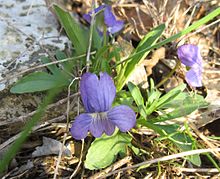The Nashville Basin, also known as the Central Basin, is a term often used to describe the area surrounding Murfreesboro, Tennessee, in which Nashville is located. The Central Basin was caused by an uplifting which produced a dome known as the Nashville Dome. The Nashville Dome is evidenced by the underlying rock strata that all dip downwards away from Nashville. The uplifting of the Nashville Dome fractured overlying strata, making it more easily eroded and thus the "dome" resulted in a "basin". Uplifted strata in the center of a geological dome have higher potential erosive energy than the surrounding strata, because they are physically higher. Erosion thus acts on the uplifted area at a greater rate than on the surrounding flat-lying area, creating a low area, i.e. a basin. This area is more correctly referred to as the "Central Dome" of Tennessee.
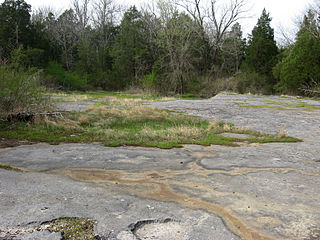
A calcareous glade is a type of ecological community that is found in the central eastern United States. Calcareous glades occur where bedrock such as limestone occurs near or at the surface, and have very shallow and little soil development. Because of the shallow soil and the extreme conditions created by it, trees are often unable to grow in the glades. This creates a habitat that is usually sunny, dry, and hot. Calcareous glade vegetation is more similar to that of a desert habitat than a grassland, being dominated by small spring annuals with occasional geophytic or succulent perennials.

Echinacea tennesseensis, also known as the Tennessee coneflower or Tennessee purple coneflower, is a flowering plant in the sunflower family, endemic to the cedar glades of the central portion of the U.S. state of Tennessee.

Astragalus bibullatus, the limestone glade milkvetch or Pyne's ground plum, is an endangered species of flowering plant that is endemic to the cedar glades of the central basin of Tennessee in the United States. It is found in only eight populations located within a few kilometers of each other in Rutherford County, Tennessee.

Elsie Quarterman was a prominent plant ecologist. She was a Professor Emerita at Vanderbilt University.

Cedars of Lebanon State Park is a state park in Wilson County, Tennessee, in the southeastern United States. It consists of 900 acres (364 ha) situated amidst the 9,420-acre (3,810 ha) Cedars of Lebanon State Forest. The park and forest are approximately 10 miles (16 km) south of Lebanon, Tennessee.

Paysonia lyrata is a rare species of flowering plant in the family Brassicaceae known by the common name lyreleaf bladderpod. It is endemic to Alabama in the United States, where it is known from only three occurrences. It is federally listed as a threatened species.

Astragalus tennesseensis is a species of flowering plant in the legume family known by the common name Tennessee milkvetch. It is native to the United States, where it is known from Illinois, Indiana, Tennessee and Alabama. Most of the occurrences are in Tennessee.
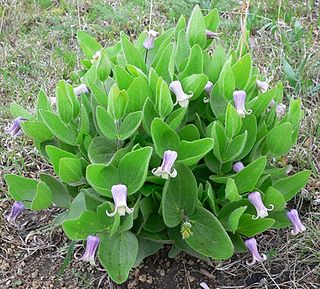
Clematis fremontii is a species of flowering plant in the buttercup family known as Fremont's leather flower. It is endemic to the United States where it is known from several disjunct populations throughout the central and southeastern states. Previously unknown populations were discovered in the mid-2000s in Tennessee and Georgia. Other names for this plant include Fremont's crowsfoot, Fremont's leather-plant, leatherplant, and rattleweed.

The Interior Low Plateaus are a physiographic region in eastern United States. It consists of a diverse landscape that extends from north Alabama across central Tennessee and Kentucky into southern Illinois, Indiana, and Ohio. Its natural communities are a matrix of temperate forests, woodlands, and prairies.

Leavenworthia is a genus of flowering plants in the family Brassicaceae. It includes about eight species native to the southern and southeastern United States. They are known generally as gladecresses.

Pediomelum subacaule is a species of flowering plant in the legume family known by the common names Nashville breadroot and whiterim scurfpea. It is native to a small area of Eastern North America, only being found in limestone cedar glades of the Interior Low Plateau and Ridge and Valley ecoregions of Alabama, Georgia, and Tennessee.

Phlox bifida, the cleft phlox or sand phlox, is native to the Midwestern United States, the Ozarks, and the cedar glades of Kentucky and Tennessee. It is found on rock outcrops, limestone glades, and in generally dry or sandy areas.

Grindelia lanceolata is a species of flowering plant in the aster family known by the common name narrowleaf gumweed.

Solidago gattingeri, common name Gattinger's goldenrod, is a species of plant that is a goldenrod. It is native only to the Ozark Mountains of Arkansas and Missouri and to the Nashville Basin of Tennessee. Its preferred habitat is cedar glades, cedar barrens, and limestone outcrops. It is adapted to dry habitats.

Lobelia gattingeri is a species of flowering plant in the bellflower family commonly called Gattinger's lobelia. It is endemic to calcareous cedar glades and barrens. It has a small range, native only to middle Tennessee, northern Alabama, and one site in the Pennyroyal Plain of Kentucky.
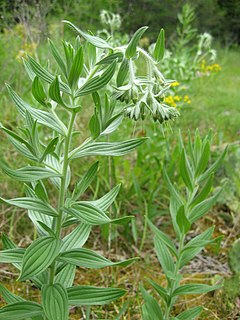
Lithospermum molle, the softhair marbleseed, is a species of flowering plant in the forget-me-not family. This species is a narrow endemic, native primarily to the Nashville Basin of Tennessee, where it is found in limestone prairies near cedar glades. There are disjunct populations in similar habitats in the Ozark Mountains of Missouri, in northwest Alabama, in Logan and Warren County, Kentucky as well as other small areas of Tennessee. Outside of Tennessee, it is very rare and perhaps no longer exists in Alabama and Kentucky due to habitat destruction. Because of its highly restricted geographic range, this species is considered vulnerable.

Leavenworthia torulosa, the necklace gladecress, is a species of plant in the mustard family. It is native to the eastern United States where it is only found near limestone cedar glades of Alabama, Georgia, Kentucky, and Tennessee. It is considered rare in all states it is found except Tennessee, where it is common in the Nashville Basin due to the abundance of available habitat.
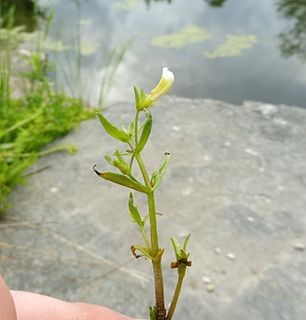
Gratiola quartermaniae, commonly known as the limestone hedge-hyssop, is a species of flowering plant in the plantain family. It is native to eastern North America.

Viola sagittata, commonly called the arrowleaf violet, is a species of flowering plant in the violet family (Violaceae). It is native to the eastern North America in Canada and the United States, where it is widespread. It is found in a variety of natural habitats, but is most common in dry, open communities such as prairies, glades, or woodlands, often in sandy or rocky soil.
